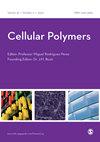Characterization of microstructures of SAN foam core using micro-computed tomography
IF 1.3
4区 医学
Q4 MATERIALS SCIENCE, BIOMATERIALS
引用次数: 1
Abstract
In this study, the microstructure of a SAN foam was imaged using a micro-CT scanner. Through image processing and analysis, variations in density, cell wall thickness and cell size in the foam were quantitatively explored. It is found that cells in the foam are not elongated in the thickness (or rise) direction of foam sheets, but rather equiaxed. Cell walls in the foam are significantly straight. Density, cell size and cell wall thickness all vary along the thickness direction of foam sheets. The low density in the vicinity of one face of foam sheets leads to low compressive stiffness and strength, resulting in the strain localization observed in our previous compressive tests. For M80, large open cells on the top face of foam sheets are likely to buckle in compressive tests, therefore being another potential contributor to the strain localization as well. The average cell wall thickness measured from 2D slice images is around 1.4 times that measured from 3D images, and the average cell size measured from 2D slice images is about 13.8% smaller than that measured from 3D images. The dispersions of cell wall thickness measured from 2D slice images are 1.16–1.20 times those measured from 3D images. The dispersions of cell size measured from 2D slice images are 1.12–1.36 times those measured from 3D images.用微计算机断层扫描表征SAN泡沫芯的微结构
在本研究中,使用微型ct扫描仪对SAN泡沫的微观结构进行了成像。通过图像处理和分析,定量探讨了泡沫中密度、细胞壁厚度和细胞大小的变化。研究发现,泡沫中的细胞在泡沫板的厚度(或上升)方向上不是伸长的,而是等轴的。泡沫中的细胞壁非常直。密度、细胞大小和细胞壁厚度沿泡沫板厚度方向变化。泡沫板单面附近的低密度导致抗压刚度和强度较低,从而导致我们在之前的抗压试验中观察到的应变局部化。对于M80,泡沫板顶部的大开口孔可能在压缩测试中弯曲,因此也是应变局部化的另一个潜在因素。2D切片图像测得的平均细胞壁厚度约为3D图像测得的1.4倍,2D切片图像测得的平均细胞大小约为3D图像测得的13.8%。二维切片图像测得的细胞壁厚度弥散度是三维图像的1.16 ~ 1.20倍。二维切片图像测得的细胞大小分散度是三维图像的1.12-1.36倍。
本文章由计算机程序翻译,如有差异,请以英文原文为准。
求助全文
约1分钟内获得全文
求助全文
来源期刊

Cellular Polymers
工程技术-材料科学:生物材料
CiteScore
3.10
自引率
0.00%
发文量
9
审稿时长
3 months
期刊介绍:
Cellular Polymers is concerned primarily with the science of foamed materials, the technology and state of the art for processing and fabricating, the engineering techniques and principles of the machines used to produce them economically, and their applications in varied and wide ranging uses where they are making an increasingly valuable contribution.
Potential problems for the industry are also covered, including fire performance of materials, CFC-replacement technology, recycling and environmental legislation. Reviews of technical and commercial advances in the manufacturing and application technologies are also included.
Cellular Polymers covers these and other related topics and also pays particular attention to the ways in which the science and technology of cellular polymers is being developed throughout the world.
 求助内容:
求助内容: 应助结果提醒方式:
应助结果提醒方式:


